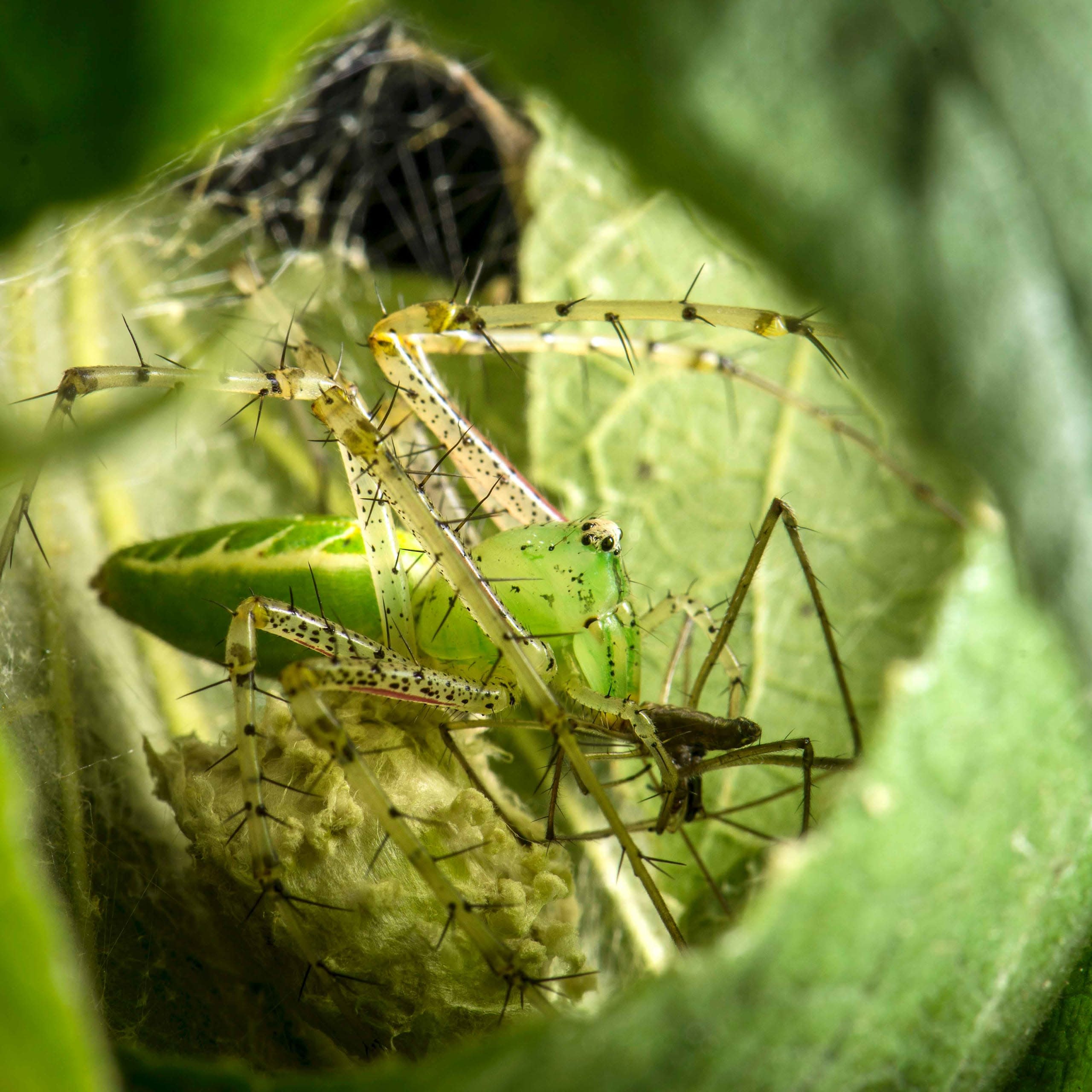 Listen to this article
•
15:34 min
Listen to this article
•
15:34 min
A necessary element of old western movies is the stand-off between two gun-slinging characters. These stand-offs typically end with one of the two characters dead. The one doing the killing would typically reason his actions with some version of “this town ain’t big enough for the both of us”. Similar stand-offs and encounters occur in the natural world at different sizes and scales. In the urban wild setting, spiders are apex predators within their own section (a plant, a wall etc.) of the larger urban ecosystem. For instance, urban gardens, empty plots with vegetation, and spaces with wild grasses play host to a variety of lynx spider species. Lynx spiders are ambush predators that sit camouflaged, waiting for their prey to come within reach of a quick sprint.
Crossing paths
What happens when different species of lynx spiders cross paths? On some select occasions, when a green lynx spider (Peucetia viridana) bumps into the comparatively smaller striped lynx spider (Oxyopes birmanicus), it results in the death of the latter. Some version of “this microhabitat ain’t big enough for the both of us” takes place. However, under normal conditions, these two species commonly occupy the same habitat without getting in each other’s business. How do these two obligate predators coexist in their urban microhabitats?
Getting to know lynx spiders
Before we dive into how these two city-dwelling predators share their hunting ground, it might be worth taking a closer look at our protagonists. Like the rest of the lynx family, a telling feature of the striped and green lynx spiders is the long spiny hair that protrudes from their limbs like spikes. These hairs are intricately connected with the spider’s nervous system and feed the spider data about vibrations and chemical changes around it. The spider then uses these sensory signals to choose its next course of action — attack potential prey, flee from a potential threat, or look utterly upset at being misidentified as a jumping spider. The larger among the two species, the green lynx spider, is typically well camouflaged among the leaves it prowls around. When you do spot it, the striking vibrant green with white accents and scattered red markings make you briefly wonder how you missed the spider in the first place. The smaller striped lynx spider has distinctly discernible lines running along its entire body (both species have straightforward, uncomplicated common names). The striped lynx spider’s subtle shades make it better suited to camouflage against backgrounds of dry leaves, grasses, and branches closer to light brown. In forests, home gardens, and fields around India, these genera of spiders fulfil a critical ecological role by preying on a wide diversity of other spiders, insects, and other small lifeforms that visit their plant residences. This brings us back to the question: How do two species that share a penchant for hunting manage to share the same space without the larger one constantly predating the smaller competitor?
Timeshare
One way in which ecologists try to make sense of these competitive situations is to study ecological niches and how they are partitioned for different actors in an environment. In its most distilled form, an ecological niche encompasses how an organism interacts with all the biotic (living) and abiotic (non-living) elements in its environment. The partitioning of these niches is simply a view showing how each organism interacts with its environment differently! These differences in interacting with their environment could be based on time. For instance, our neighbourhood shikra hunts during the day, while a barn owl visits our streets at night with almost exclusive hunting access after dark. This allows two birds of prey to forage in the same space without getting in each other’s way.
A space apart
Occasionally, niche partitions are based on space. Abhijit Dey, one of the authors of this article, observed that green and striped lynx spiders share their microhabitats by dividing up the space. Most of the larger green lynx spiders foraged on taller plants (over 40cm), while the smaller striped lynx spiders foraged on comparatively shorter plants(under 40cm). In addition to giving each other space, the prey typically consumed by the green lynx was larger than what the striped lynx spider consumed. This suggests there may also be a dietary niche partition where they do not compete for the same prey.
Egg sac conundrum
Alas, the lynx spider world, of living at a certain height and letting live at a different height, does come with exceptions. Despite the general tendency of these two species to operate at different heights, Abhijit found that they overlapped significantly in their choice of height when it came to building egg sacs (silken cradles that safely store eggs until they hatch). The preference to build an egg sac at the highest point possible is likely a consequence of the lynx spiders’ method of dispersal — ballooning. Shortly after they have hatched, lynx spiders find a high point and extrude a long line of silk into the air. A combination of moderate wind speed and electrical charge in the air allows the young spider’s line of silk to gently lift it off its perch and fly across vast distances (hundreds of kilometres if the conditions are conducive). This process of flying using silk is called “ballooning”, and both species of lynx spiders seem keen on giving their offspring the best starting point for this seemingly magical (they are surfing electricity!) mode of dispersal.
It is primarily to better her offspring’s chances of survival that the striped lynx spider risks life and limb by entering the spatial niche of the larger green lynx spider. Otherwise, these two fang-slinging predators seem to have found that garden and field habitats are indeed “big enough for the both of them”.













